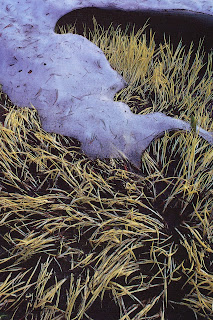"Take time to look" says Georgia O'Keeffe. I have this printed on a beautiful oval pebble bought at the Nevada Museum of Art and it sits on my desk. It's a very lovely thing and an important thought which I held in my mind as I began working on my book. At every step checking that my plans really were producing a result I liked, that each aspect was integrated with the whole, and when it didn't changing my mind and testing out an alternative.
I find history and stories irresistible, so discovering a back story for this work was essential. Right from the start the sea and lives lived on and by the sea were in my mind. The sea's power, strength and effects were part of that picture. I began with the lives of fishermen and herring girls, latterly it was the stories of of refugees leaving North Africa, their escape holding the possibility of failure and drowning in the Mediterranean.
"Lost at Sea" is now finished and though I'd hoped to write on all the pages I've only managed the title. The book itself though, I think, I hope, hints at the stories that were on my mind during the process of making it. It's an extraordinary thing to be able to realise ideas through my fingers in this way.
Taking time to look, to take apart, to change and above all to reduce the techniques, materials and ideas to just a few have been essential to the success of this project.
 |
| 11:5 Creative Journey |
 |
| 11:6 Embroidered Item |
 |
| 11:7 Title Page |
This has been by far the most complex item I've ever made. Learning how to paper make, do drawn thread work, combine the two and then add stitch, both machine and hand, to say nothing of using dye so that the colours were just right. So my very first comment, and probably an obvious one, is that the book is successful because I've practised each technique until I felt really comfortable with it. As a result the stories in my mind had an opportunity to flourish and be a part of the finished article.
Although the book uses many techniques, it became integrated through its materials. The use of rough edged handmade paper is echoed by the incomplete machine and hand stitching. The sari waste stitched over string (Sian's suggestion) has a torn edge which mirrors the look and feel of the paper edges. Colour too plays a part in how the book comes together. I've used the same dyes for both the paper and fabric.
Does it work as a book? Yes, I scored both the cover and each page so it opens beautifully. This is also helped by the large hand-cut holes (five in each page!) necessary to thread the sari waste through. The title and section pages are all washed with a PVA/water combination which can be written on. Other pages will need treating if I am to write more, though photographs might work well printed on light paper so that the holes don't tear.
The book is a handmade thing and therefore will need careful handling, possibly even a box in which to keep it.
I have noticed that it pivots slightly on the sari waste.
What changes might I make? Possibly two.
Referring to the comment above about the book pivoting slightly on the sari waste, I would consider doing underties in clear plastic thread which would be largely hidden.
The second change is an aesthetic one. I would strengthen the colour of the under paper on the cover. This would give slightly more contrast between the wax markings, which show up white when the colour wash is applied, thus giving the cover more interest. However this might throw the colour balance out of kilter and make the book look less "Lost at Sea."
And what of the seed packets?
This idea was something I'd found very exciting. First I stuck seeds to readimade labels and tried to add pulp to soften the effect. The finish on the label prevented the pulp from adhering. Then I cut labels from my own paper, PVA-ed seeds on as before and then applied pulp. The result was so-so. I added stitching - better. Added some folds to show wear, but somehow the colours, which had leaked into the paper and were fairly dominant, were at odds with my book. So applying the "Take time to look" mantra, the idea had to go.
 |
| 11:8 Seed Tags |











































